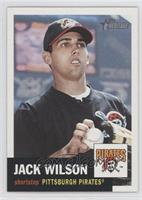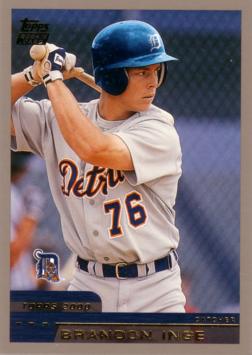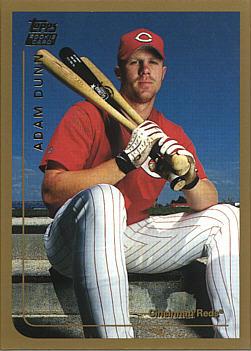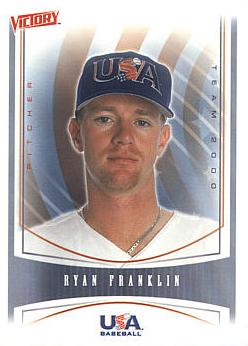 The top picks have been analysed. Now it's time to take a look at the middle of the pack guys, the players who rank from 11-23. This list will encompass all available players with a career WAR above 10.0. Eight of the 13 players on this list played in at least one All-Star game. Of the five that didn't, two of them are still playing to this day. So while you won't find names like Pujols and Ichiro, there are still some quality players, if not quality seasons from the guys in this pack.
The top picks have been analysed. Now it's time to take a look at the middle of the pack guys, the players who rank from 11-23. This list will encompass all available players with a career WAR above 10.0. Eight of the 13 players on this list played in at least one All-Star game. Of the five that didn't, two of them are still playing to this day. So while you won't find names like Pujols and Ichiro, there are still some quality players, if not quality seasons from the guys in this pack.As noted before, the players are ranked here solely on their overall WAR accumulation numbers for their entire MLB career. With that being said, let's get to the list.
 11.) JACK WILSON - 23.5 WAR
11.) JACK WILSON - 23.5 WARhttp://www.baseball-reference.com/players/w/wilsoja02.shtml
Here is a guy who is never going to be confused for Nomar Garciaparra or Derek Jeter. Jack Wilson is a very good fielder who put together a couple of good offensive season along the way of his 12-year MLB career. He can play right out of the box, but his 2001 season is pretty poor offensively. In 2002, he has a very good season against LHP (.360/.402/.526). Wilson was an All-Star in 2004 when he belted 41 doubles, 12 triples and 11 homers while batting .308. He actually won the Silver Slugger Award that year. He has three more full-time seasons after '04. His career OPS is only .671, and he never stole more than eight bases in a single season. Wilson is basically a glove man.
 12.) JUAN URIBE - 20.9 WAR
12.) JUAN URIBE - 20.9 WARhttp://www.baseball-reference.com/players/u/uribeju01.shtml
Juan Uribe arrived in Colorado in 2001 as a 22-year old from the Dominican Republic. He batted .300 in his rookie season. And while Uribe has never made an All-Star game, they guy is still playing to this day and is actually improving with age. He's had a sneaky good career, topping 15 homers a half-dozen times while playing all the infield positions. He is a very good fielder, actually carrying "A" range at the SS position in both 2002 and 2003. Uribe had two very good years in San Francisco in 2009 and 2010. And one could make the argument that his two best years as a player have been his last two in 2013 and 2014, at the age of 34 and 35.
 13.) DAVID ECKSTEIN - 20.8 WAR
13.) DAVID ECKSTEIN - 20.8 WARhttp://www.baseball-reference.com/players/e/eckstda01.shtml
The third straight shortstop to hit the list is David Eckstein, and one could argue that he's the best of the bunch. Eckstein hits the ground running in 2001 with a very solid season, one that netted him a 4th place finish in the American League ROY voting. He followed that up with his best offensive season in 2002. He was traded from Anaheim to St. Louis following the 2004 season and became an All-Star for the Cardinals, making the team in both 2005 and 2006. Never a source of power, Eckstein finished his career with a .280 BA and .345 OBP while averaging 15 stolen bases per year.
 14.) KYLE LOHSE - 20.8 WAR
14.) KYLE LOHSE - 20.8 WARhttp://www.baseball-reference.com/players/l/lohseky01.shtml
Kyle Lohse is another guy on this list who is getting better with age. From 2011-2014, he's averaged 13 wins with a 3.30 ERA and 1.157 WHIP. Unfortunately, his career started a little differently. From 2001-2010, Lohse average only nine wins with a 4.79 ERA and 1.431 WHIP. If you draft Lohse with the intention of pitching him out of the gate, you better like high scoring games. His rookie ERA was 5.68. He improves in 2002 to a respectable 4.23 ERA in 31 starts. His first really good year is in 2008 when he won 15 games and posted a 3.78 ERA in 33 starts in his first year in St. Louis (thank you Dave Duncan).
 15.) AARON ROWAND - 20.8 WAR
15.) AARON ROWAND - 20.8 WARhttp://www.baseball-reference.com/players/r/rowanaa01.shtml
Aaron Rowand breaks in with a solid season, hitting .293 with a .385 OBP in 123 limited at-bats. He becomes a good to very good player in 2004, a season where he hit .310 with a .910 OPS. During a four year stretch from 2004 to 2007, Rowand compiles a triple slash line of .289/.348/.474, averaging 34 doubles, 19 home runs and 12 stolen bases during that time frame. His best season came in 2007 when he hit .309 with 45 doubles and 27 homers, earning him his only All-Star game appearance. He finishes out his career in San Francisco from 2008-2011, where he slips to a .253/.310/.394 slash line.
 16.) BRANDON INGE - 19.1 WAR
16.) BRANDON INGE - 19.1 WARhttp://www.baseball-reference.com/players/i/ingebr01.shtml
You will have to wait a few years on Inge if you draft him. He came up as a catcher, but after three less than stellar seasons behind the plate, he moved into a utility role in 2004 and began to carve out a serviceable career, especially against left-handed pitching. He has a couple seasons where he hits 27 homers. He was an All-Star in 2009 despite only hitting .230 for the season. His best year was probably 2004 when he plays six different positions, hits a career high .287 with a .340 OBP. Inge's greatest asset is his glove. He earned either "A" or "A+" range ratings at 3B from 2005 to 2009, seasons which he averaged 19 homers offensively.
 17.) ADAM DUNN - 16.9 WAR
17.) ADAM DUNN - 16.9 WARhttp://www.baseball-reference.com/players/d/dunnad01.shtml
It's hard to believe that Adam Dunn isn't ranked higher on this list. Truth is, he probably should be, but his WAR numbers have actually been on the decline since he left Cincinnati during the 2008 season. He broke into the league in 2001, bashing 19 HRs in only 266 at-bats, finishing 4th in the NL ROY voting. He was an All-Star in 2002 when he hit 26 homers with a .400 OBP. From 2004-2008, he hit over 40 HRs every year while compiling a .382 OBP and a .915 OPS. His WAR with the Reds was 16.4 in eight season. From 2009-2014, his WAR is 0.4 with four different teams, mostly because of poor BA numbers. For his 14-year career, Dunn has hit 462 home runs while compiling a .365 on-base percentage.
 18.) MARCUS GILES - 16.7 WAR
18.) MARCUS GILES - 16.7 WARhttp://www.baseball-reference.com/players/g/gilesma01.shtml
Marcus Giles only played seven seasons in the Major League's, retiring after the 2007 season. In his short career, he had a couple really good years. His first two years are nothing special as he's a part-time player. He became a regular in 2003 and was an All-Star that year, hitting .316/.390/.526 with 49 doubles, 21 homers and 14 stolen bases. His next two years were also quite good. He averaged 39 doubles, 15 home runs and 16 stolen bases from 2003-2005, compiling a very good .858 OPS from the second-base position. He declines in 2006 to a .729 OPS. He declines even further in 2007 to only .621 OPS and as mentioned before, retires after that season.
 19.) JOEL PINEIRO - 13.7 WAR
19.) JOEL PINEIRO - 13.7 WARhttp://www.baseball-reference.com/players/p/pineijo01.shtml
Joel Pineiro is an odd case. He comes into the league with a bang. Pineiro is 40% limited in 2001, but he's awesome when you can use him, compiling a 2.03 ERA and 0.942 WHIP, limiting right-handed batters to a .150/212/.197 slash line. His next two years are also very good, with ERA's of 3.24 and 3.78 respectively. He's actually "jam" rated on his 2002 card. But after '03 the wheels fall off. From 2004-2008, his ERA is 5.34 with a 1.471 WHIP. But then something happens - he remembers how to pitch again (again, thank you Dave Duncan). In 2009 and 2010, he wins 25 games and has a 3.64 ERA and 1.185 WHIP.
 20.) JAKE WESTBROOK - 12.8 WAR
20.) JAKE WESTBROOK - 12.8 WARhttp://www.baseball-reference.com/players/w/westbja01.shtml
Jake Westbrook is the epitome of an average pitcher. For his 13-year MLB career, he won 105 games compared to 103 losses, compiling a a very average 4.32 ERA and 1.405 WHIP along the way. If you draft Westbrook you will have to wait a couple years before he's useful. His first decent year is 2003. The following season is his best as a pro. Westbrook was an All-Star in 2004 when he went 14-9 with a 3.38 ERA, earning him a "jam" rating on his card. His career is interrupted in 2009 due to injury. He comes back in 2010 and has a 3.48 ERA in 12 starts for St. Louis (Dave Duncan). He remains very average the rest of his career. In his final four seasons, he went 42-39 with a 4.34 ERA.
 21.) RYAN FRANKLIN - 11.6 WAR
21.) RYAN FRANKLIN - 11.6 WARhttp://www.baseball-reference.com/players/f/frankry01.shtml
The next guy on our list is pitcher Ryan Franklin, who splits his time in his career between being a starter and a reliever. He starts out his career in 2001 out of the bullpen, and has a decent season in long-relief with a 3.56 ERA and decent splits. He splits his time between the pen and the rotation in 2002 and again is decent. He becomes a full-time starter in 2003 and has a good year with a 3.57 ERA, earning a "jam" rating. He continues as a starter in 2004 and 2005 with mixed results before returning to the bullpen full-time in 2006. Franklin has one exceptional year in 2009 when he earned 38 saves with a 1.92 ERA for the Cardinals (Dave Duncan).
 22.) BRAD WILKERSON - 11.0 WAR
22.) BRAD WILKERSON - 11.0 WARhttp://www.baseball-reference.com/players/w/wilkebr01.shtml
Brad Wilkerson breaks into the league in 2001 with a limited usage card that is barely usable. He was technically a rookie in 2002, a season which saw him finish 2nd in the NL ROY voting after compiling a triple slash line of .266/.370/.469 for an .840 OPS. Wilkerson actually improves on those numbers in 2003 with a .844 OPS while stealing 13 bases, then improves again in 2004 with a .872 OPS, again swiping 13 bags. He never cracks .800 OPS again in his career, but from 2005-2007 he averages a respectable .757. For his career, Wilkerson compiled a .350 OBP and averaged nearly 20 homers a year.
 23.) CHAD BRADFORD - 10.0 WAR
23.) CHAD BRADFORD - 10.0 WARhttp://www.baseball-reference.com/players/b/bradfch01.shtml
Our final guy on the list is reliever Chad Bradford. If you're looking for a quality arm out of the bullpen who lasts for a long time, Bradford is your guy. While he was never a closer, accumulating only 11 career saves in his 13 year career, Bradford was a pretty decent setup guy. From 2001-2008, he compiled a 3.15 ERA. He never really has a bad season during that stretch, his worst year being 2004 when he had a 4.42 ERA. He had three seasons with ERA's under 3.00 in that eight year stretch, with only the one above 4.00. His submarine delivery made him especially good against right-handed batters, who hit only .245 against him in his career.
Some decent players in this group. A few exceptional, All-Star type seasons. Half of these guys are good right away, while the other half you will have to wait on a season or two to become valuable. Next up will be the fringe guys - the one or two year players or utility type guys. Stay tuned.
No comments:
Post a Comment